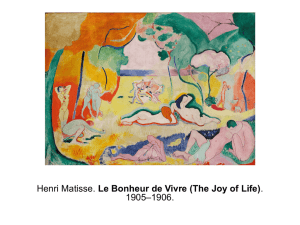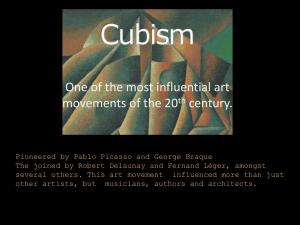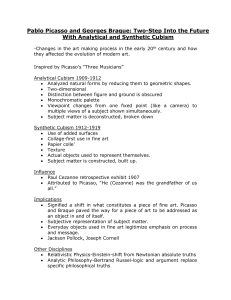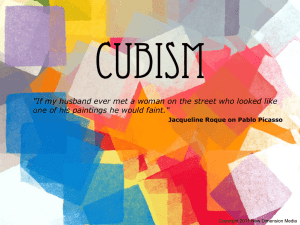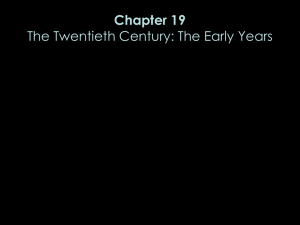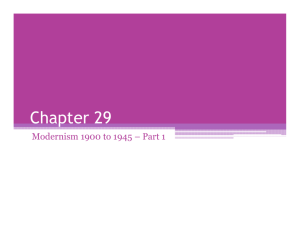Pablo Picasso
advertisement
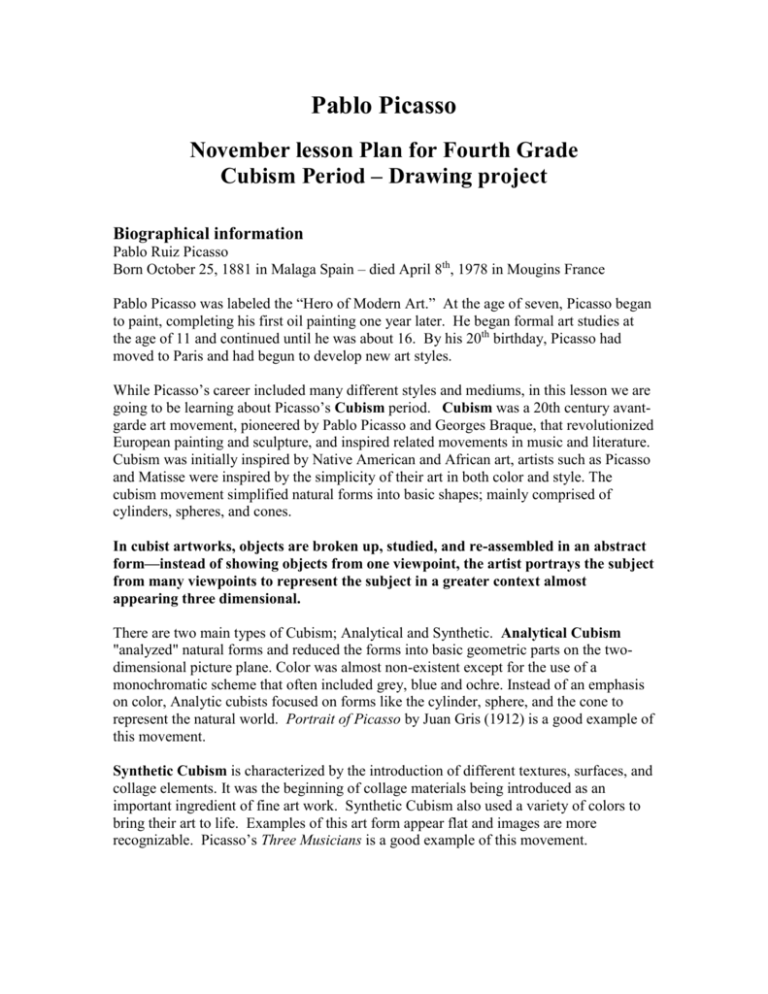
Pablo Picasso November lesson Plan for Fourth Grade Cubism Period – Drawing project Biographical information Pablo Ruiz Picasso Born October 25, 1881 in Malaga Spain – died April 8th, 1978 in Mougins France Pablo Picasso was labeled the “Hero of Modern Art.” At the age of seven, Picasso began to paint, completing his first oil painting one year later. He began formal art studies at the age of 11 and continued until he was about 16. By his 20th birthday, Picasso had moved to Paris and had begun to develop new art styles. While Picasso’s career included many different styles and mediums, in this lesson we are going to be learning about Picasso’s Cubism period. Cubism was a 20th century avantgarde art movement, pioneered by Pablo Picasso and Georges Braque, that revolutionized European painting and sculpture, and inspired related movements in music and literature. Cubism was initially inspired by Native American and African art, artists such as Picasso and Matisse were inspired by the simplicity of their art in both color and style. The cubism movement simplified natural forms into basic shapes; mainly comprised of cylinders, spheres, and cones. In cubist artworks, objects are broken up, studied, and re-assembled in an abstract form—instead of showing objects from one viewpoint, the artist portrays the subject from many viewpoints to represent the subject in a greater context almost appearing three dimensional. There are two main types of Cubism; Analytical and Synthetic. Analytical Cubism "analyzed" natural forms and reduced the forms into basic geometric parts on the twodimensional picture plane. Color was almost non-existent except for the use of a monochromatic scheme that often included grey, blue and ochre. Instead of an emphasis on color, Analytic cubists focused on forms like the cylinder, sphere, and the cone to represent the natural world. Portrait of Picasso by Juan Gris (1912) is a good example of this movement. Synthetic Cubism is characterized by the introduction of different textures, surfaces, and collage elements. It was the beginning of collage materials being introduced as an important ingredient of fine art work. Synthetic Cubism also used a variety of colors to bring their art to life. Examples of this art form appear flat and images are more recognizable. Picasso’s Three Musicians is a good example of this movement. Vocabulary Words Avant garde - means "advance guard" or "vanguard”. The adjective form is used in English, to refer to people or works that are experimental or innovative, particularly with respect to art, culture, and politics. Abstract - art that departs significantly from natural appearances. Monochromatic - generally used to describe a painting, drawing, design, or photograph produced in one color or shades of one color. Discussion Questions Here are a few questions to ask the students while showing examples of Picasso’s works of art. Why do you think he chose to use geometric shapes to depict his art? Do you think he could have created a similar piece of art by painting the image in a more realistic form? Do you see any sort of pattern that he seems to use in his artwork? Here are some questions to ask the students after they have completed their project. If time allows, they can even use their own works of art to answer the following. Was it difficult to recreate the instrument using basic shapes? Did they like creating art this way? What else could they draw using this method? Picasso Cubism – Drawing project Materials: white paper, colored pencils, black crayon. View - The Three Musicians painting Demonstrate the lesson by following these step-by-step instructions; please remember to have the students put their name on their paper. There should be no structured form of evaluation, just observe the children and be sure that they are creative as possible. 1. Provide each student with colored pencils and white paper. 2. Display pictures of musical instruments. 3. Have the students sketch one of the musical instruments using basic shapes (circle, square, triangle, etc.). In keeping with the cubism style, encourage students to make objects large and fill up the space of the paper. Just like Picasso, the image does not need to look exactly as it does in real life. Encourage them to be an Abstract artist, and perhaps zoom in on a part of the image instead of the whole. 4. When students are finished, have them trace their shapes with a black crayon. If time allows, they can add color with colored pencils. Pablo Picasso Three Musicians Synthetic Cubism used a variety of colors to bring the art to life. Examples of this art form appear flat and images are more recognizable. The Mandolin, 1910 Analytic Cubism focused on forms like the cylinder, sphere, and the cone to bring images to life. Color was not widely used as most paintings were created in monochromatic color schemes. Instrument Examples


